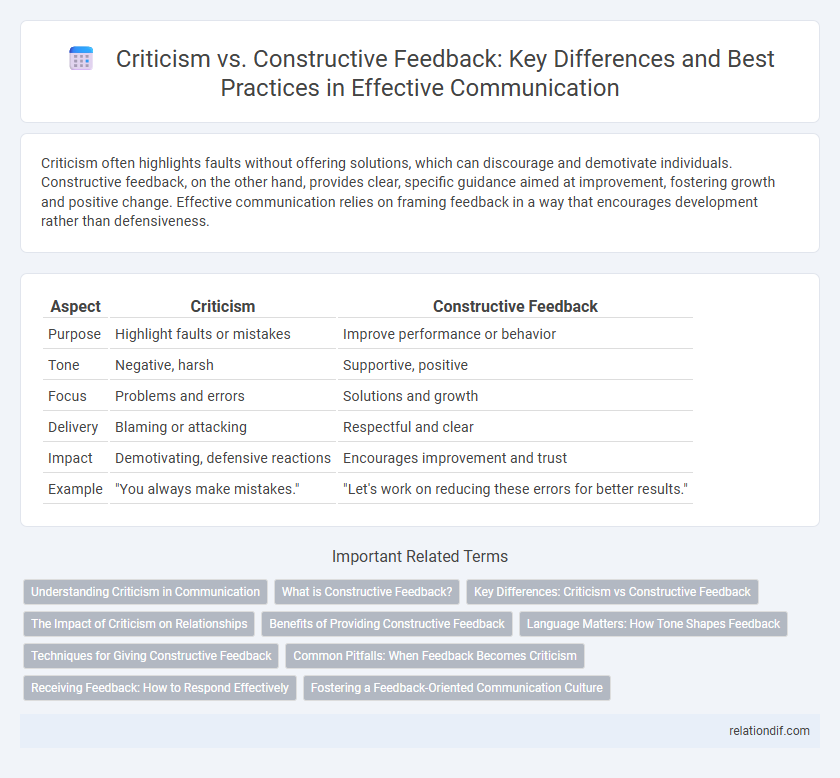Criticism often highlights faults without offering solutions, which can discourage and demotivate individuals. Constructive feedback, on the other hand, provides clear, specific guidance aimed at improvement, fostering growth and positive change. Effective communication relies on framing feedback in a way that encourages development rather than defensiveness.
Table of Comparison
| Aspect | Criticism | Constructive Feedback |
|---|---|---|
| Purpose | Highlight faults or mistakes | Improve performance or behavior |
| Tone | Negative, harsh | Supportive, positive |
| Focus | Problems and errors | Solutions and growth |
| Delivery | Blaming or attacking | Respectful and clear |
| Impact | Demotivating, defensive reactions | Encourages improvement and trust |
| Example | "You always make mistakes." | "Let's work on reducing these errors for better results." |
Understanding Criticism in Communication
Criticism in communication often highlights perceived flaws or mistakes, which can trigger defensive reactions and hinder effective dialogue. Understanding criticism requires distinguishing between negative judgment and opportunities for growth, emphasizing the intent behind the message. Clear, respectful communication transforms criticism from a barrier into a catalyst for improvement and mutual understanding.
What is Constructive Feedback?
Constructive feedback is a purposeful communication method aimed at improving performance by highlighting specific strengths and areas for development with actionable suggestions. It emphasizes clarity, respect, and support to foster growth and motivation rather than blame or negativity. Effective constructive feedback enhances collaboration, encourages positive change, and builds trust within professional and personal relationships.
Key Differences: Criticism vs Constructive Feedback
Criticism focuses on highlighting faults or shortcomings, often without offering solutions, which can lead to decreased motivation and defensiveness. Constructive feedback, however, emphasizes specific behaviors and provides actionable suggestions aimed at improvement and growth. The key difference lies in intent: criticism may undermine confidence, while constructive feedback fosters development and positive change.
The Impact of Criticism on Relationships
Criticism often damages trust and creates emotional distance in relationships by highlighting faults without offering solutions. Constructive feedback, in contrast, fosters growth and mutual understanding by addressing issues with empathy and actionable suggestions. The impact of criticism on relationships can lead to defensiveness, reduced collaboration, and increased conflict, whereas constructive feedback promotes resilience and positive change.
Benefits of Providing Constructive Feedback
Providing constructive feedback fosters personal and professional growth by highlighting specific areas for improvement and offering actionable suggestions. It enhances communication by building trust and encouraging open dialogue, which leads to stronger relationships within teams. Constructive feedback also boosts motivation and performance, creating a positive environment that supports continuous learning and development.
Language Matters: How Tone Shapes Feedback
Tone plays a crucial role in differentiating criticism from constructive feedback, as it influences how the message is perceived and received. A neutral or positive tone encourages openness and growth, while a harsh or sarcastic tone often triggers defensiveness and resistance. Effective communication leverages empathetic language to foster understanding and motivate improvement.
Techniques for Giving Constructive Feedback
Effective techniques for giving constructive feedback include using specific, behavior-focused language that avoids personal attacks or generalizations. Applying the "SBI" model--Situation, Behavior, Impact--clarifies context and consequences without ambiguity. Encouraging two-way dialogue and offering actionable suggestions foster understanding and motivate positive change in communication.
Common Pitfalls: When Feedback Becomes Criticism
Feedback often becomes criticism when it focuses on personal faults rather than specific behaviors, leading to defensiveness and reduced motivation. Common pitfalls include vague language, such as "You're not doing well," which lacks actionable insight and fosters resentment. Effective communication requires clarity, specificity, and a positive intent to transform potential criticism into constructive feedback that promotes growth.
Receiving Feedback: How to Respond Effectively
Receiving feedback effectively requires active listening and maintaining an open mindset to distinguish criticism from constructive feedback. Respond by acknowledging the input objectively, asking clarifying questions to understand specific points, and avoiding defensive reactions that hinder personal growth. Employ strategies such as paraphrasing and summarizing comments to demonstrate engagement and foster a positive communication environment.
Fostering a Feedback-Oriented Communication Culture
Fostering a feedback-oriented communication culture requires distinguishing criticism from constructive feedback by emphasizing specific, actionable insights that promote growth and improvement. Encouraging open dialogue and active listening helps build trust, making individuals more receptive to feedback and motivated to enhance their performance. Creating an environment where feedback is viewed as a valuable tool rather than personal judgment strengthens collaboration and drives continuous development.
Criticism vs Constructive Feedback Infographic

 relationdif.com
relationdif.com